- 성평등(Gender Equality) 관련 인식 - WIN 다국가 조사
- 조사일 : 2020/12/15
- [GallupReport(20210310)_Gender_WIN.pdf] 다운로드
● 2021년 3월 10일(수) 공개 | 문의: 02-3702-2571/2621/2622
성평등(Gender Equality) 관련 인식 - WIN 다국가 조사
→ 한국+세계 조사 결과 파일 다운로드(PDF)
/ 세계 조사 개요
2020년 10~12월 34개국 성인 총 29,252명 전화/온라인/면접조사(주제별 참여국 상이)
/ 한국 조사 개요
- 조사기간: 2020년 11월 5~29일
- 표본추출: 2단계 층화 집락 무작위 추출
- 응답방식: 면접조사원 인터뷰
- 조사대상: 전국(제주 제외) 만 19세 이상 1,500명
- 표본오차: ±2.5%포인트(95% 신뢰수준)
- 응답률: 26%(총 접촉 5,856명 중 1,500명 응답 완료)
- 의뢰처: 한국갤럽-WIN 자체 조사
/ 조사 항목
- 영역별 성평등 성취 여부: 일터·직장 / 정치 / 가정
- 지난 1년간 정신적, 신체적 등 어떤 형태의 폭력으로 고통받은 적이 있는가?
- 지난 1년간 성희롱을 당한 경험이 있는가?
(※ 세계 조사 상세 결과는 첨부 파일 참조)
요약
- 34개국 성인 영역별 성평등 성취 동의율: 가정 71%, 직장·일터 60%, 정치 51%
- 대체로 남성이 여성보다 더 성평등한 사회에 산다고 인식
- 핀란드는 3개 영역 모두 조사 참여국 중 5위 안, 일본은 매년 최하위권
- 한국은 다른 나라보다 남녀 간 시각차 큰 편
- 폭력에 따른 고통 경험률 높은 나라가 대체로 성희롱 피해 경험률도 높아
조사 결과
2020년 10~12월 34개국 성인, 영역별 성평등 성취 동의율:
가정 71%, 직장·일터 60%, 정치 51%
- 대체로 남성이 여성보다 더 성평등한 사회에 산다고 인식
- 한국은 조사 참여국 평균 수준이지만, 다른 나라보다 남녀 간 시각차 큰 편
글로벌 조사 네트워크 WIN이 2020년 10~12월 34개국 성인 29,252명에게 성평등이 얼마나 이뤄졌는지에 대한 주관적 인식을 일터·직장, 정치, 가정 등 3개 영역별로 물었다(4점 척도). 그 결과 34개국 성인 중 71%가 자국의 가정에서 '성평등이 (확실히+어느 정도) 이뤄졌다'고 답했다. 직장·일터에서 '성평등이 이뤄졌다'(이하 '성취')는 응답은 60%, 정치 영역에 대해서는 51%로 나타났다.
◎ 34개국 중에서 핀란드는 영역별 성평등 성취 응답(일터·직장 80%, 정치 90%, 가정 86%)이 모두 5위 안에 들었다. 반면, 일본(일터·직장 32%, 정치 19%, 가정 45%)은 예년과 마찬가지로 최하위권에 머물렀다.
◎ 이번 조사는 34개국 성인이 자국에서 성평등이 얼마나 이루어졌다고 느끼는지에 대한 인식만을 알아본 것이다. 유엔개발계획(UNDP)의 성불평등지수(GII)나 세계경제포럼(WEF)의 성별격차지수(GGI) 등은 주로 국가 통계, 법적·경제적 제도와 권리 등 여러 측면을 포괄하여 산출된다는 차이가 있다. 즉, 개인이 느끼는 자국의 성평등 정도가 반드시 그 나라의 객관적 성평등 수준을 의미하는 것은 아님에 주의해야 한다.
◎ 국가별, 응답자 특성별 성평등 성취 여부 인식 비교를 좀 더 쉽게 하기 위해 순(純)지수(Net Score: 성취-미성취 응답 차이, 수치가 클수록 더 성평등하다고 느낌) 기준으로 보면 34개국 전체 평균은 가정 47, 일터·직장 26, 정치 8 순이다. 1년 전과 비교하면 정치 영역에서 성평등 성취 순지수가 소폭 상승했고(2→8) 일터·직장(25→26), 가정(48→47) 영역은 거의 변함없었다.
◎ 3개 영역 성평등 성취 순지수를 성별로 보면 정치에서 남성(17)과 여성(0) 차이가 17, 일터·직장(남성 35, 여성 18)에서는 17, 가정(53, 40)에서 13이다. 즉, 전반적으로 남성이 여성보다 더 성평등한 사회에 산다고 느끼는 것이다. 이는 지난 3년간 조사에서 일관된 경향이다.
◎ 한국 조사는 작년 11월 5~29일 전국(제주 제외) 성인 1,500명을 대상으로 했다. 그 결과 한국인의 영역별 성평등 성취 응답은 가정 73%, 일터·직장 61%, 정치 영역 48%로 나타났다. 이는 조사 참여국 평균과 비슷한 수준이지만, 다른 나라보다 남녀 간 시각차가 큰 편이라는 데 주목할 만하다.
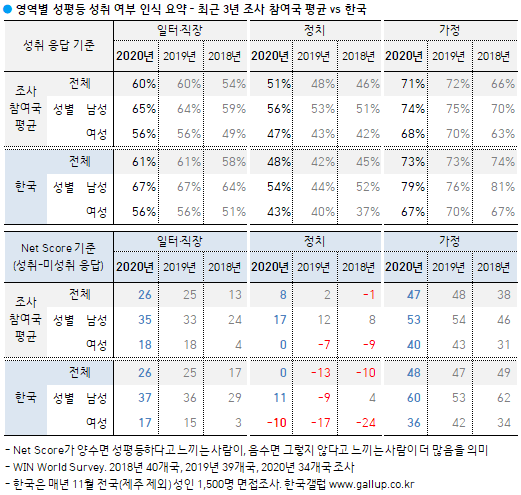
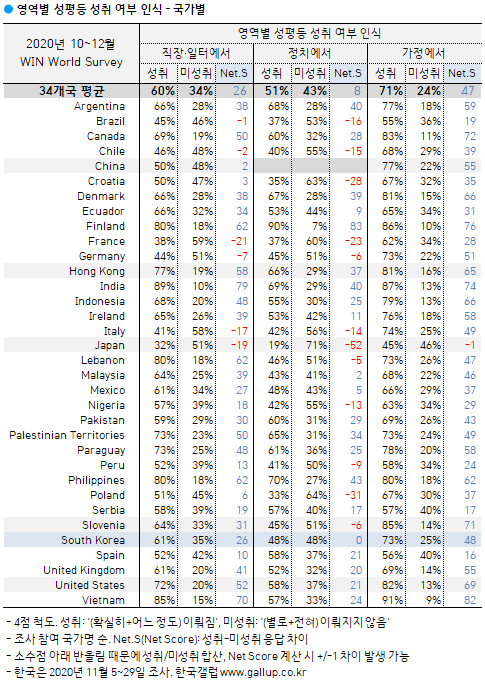
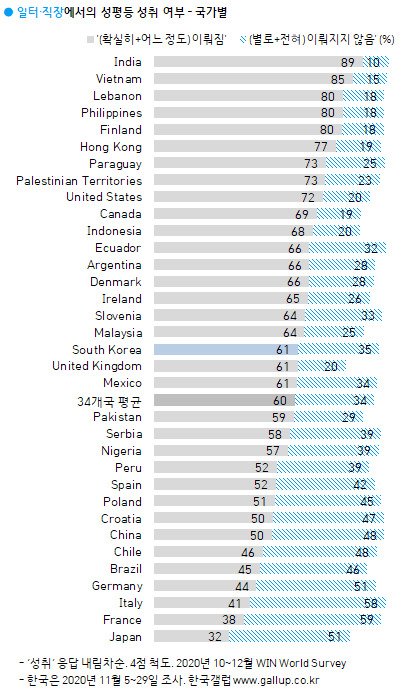
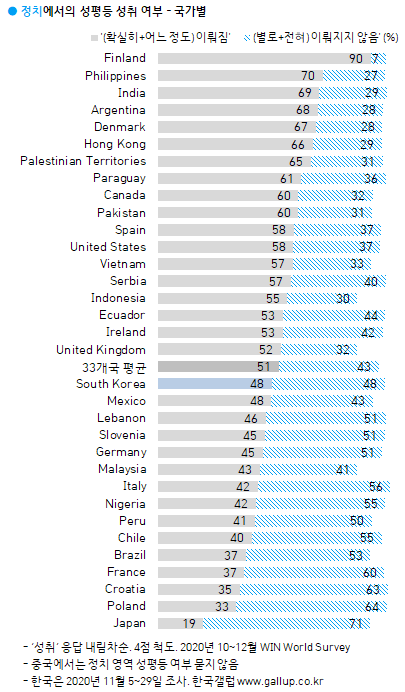
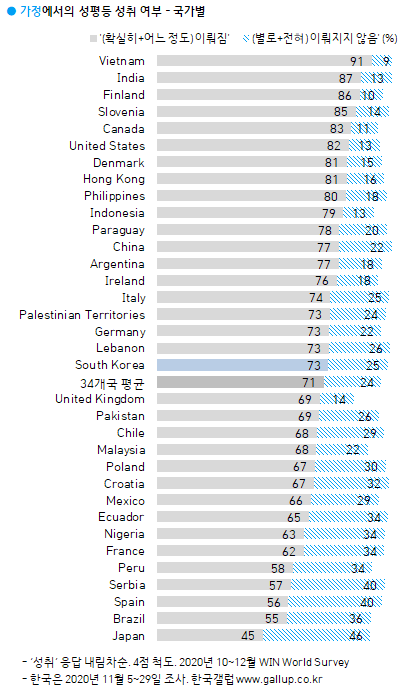
__
한국 교차 집계표
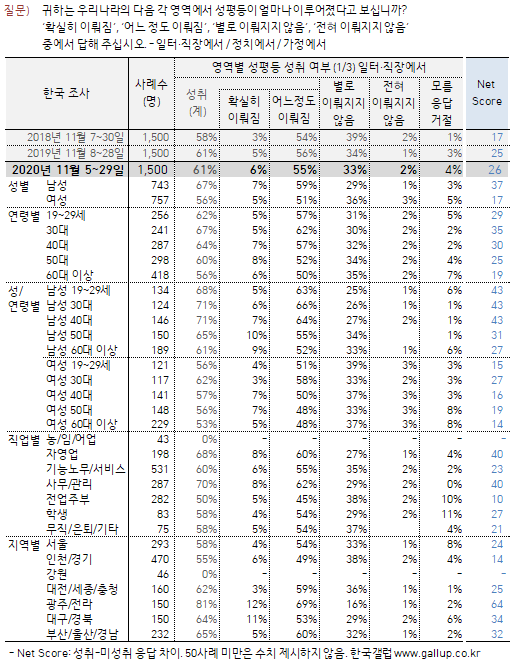
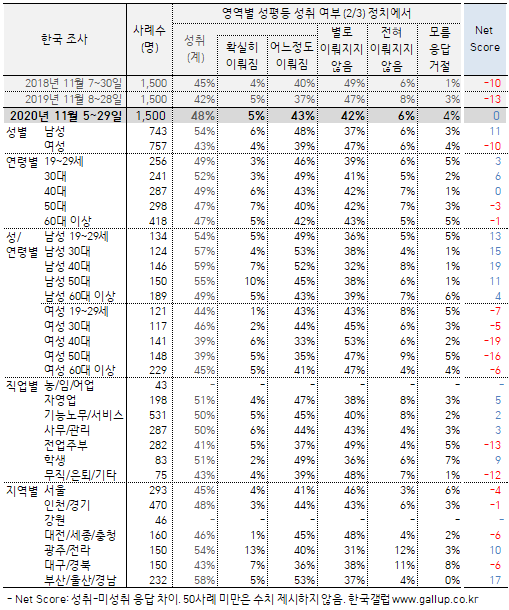
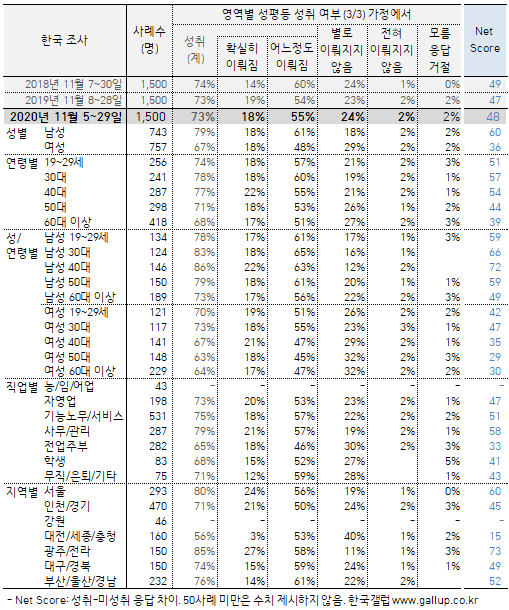
___
33개국 성인 중 15%, '지난 1년간 어떤 형태의 폭력으로 고통받은 적 있다'
- 주요국 경험률: 인도 40%... 일본·미국 12%, 중국·한국 5%
33개국 성인에게 지난 1년간 정신적·신체적 등 어떤 형태의 폭력으로 고통받은 적 있는지 물은 결과 15%가 '있다'고 답했다. 폭력으로 고통받은 경험률은 남성 14%, 여성 17%다. 연령별로 보면 젊은 층에서 그 비율이 높았다(18~24세 21%, 25~34세 18%; 55~64세 11%, 65세 이상 6%).
◎ 조사 참여국 중 지난 1년간 어떤 형태의 폭력으로 고통받은 경험률이 가장 높은 나라는 인도(40%), 아르헨티나(31%), 칠레(30%), 멕시코(27%) 순이다. 그 외 주요국 경험률은 홍콩 19%, 일본과 미국이 각각 12%, 독일 8%, 영국 6% 등이며 한국은 5%로, 중국(5%), 베트남(1%)과 함께 낮은 편에 속했다.
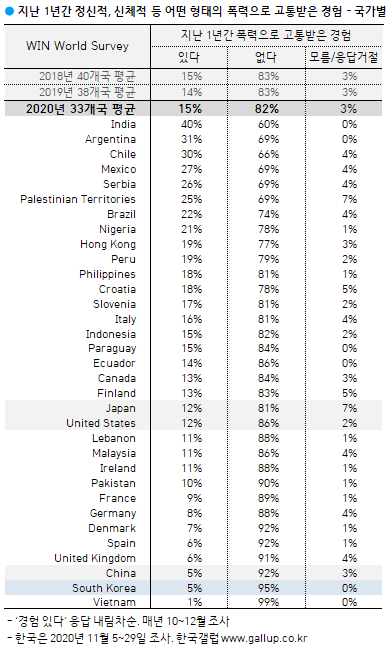
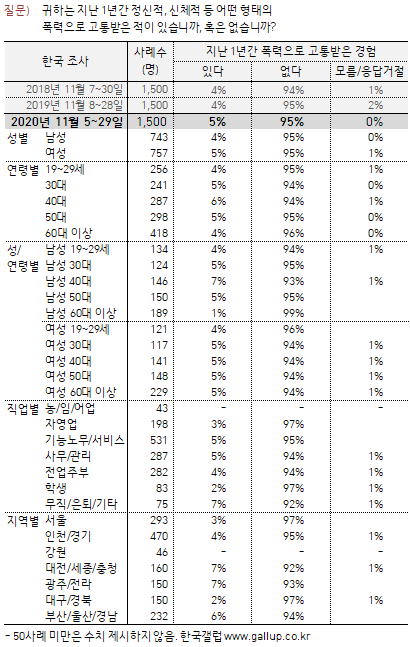
___
31개국 성인 중 7%, '지난 1년간 성희롱 당한 경험 있다' - 여성은 10%
- 주요국 경험률: 인도(23%)... 미국 7%, 일본 6%, 중국 3%, 한국 1%
- 폭력에 따른 고통 경험률 높은 나라가 대체로 성희롱 피해 경험률도 높아
31개국 성인 중 7%가 지난 1년간 성희롱을 당한 경험이 있다고 답했으며, 여성의 성희롱 피해 경험률은 10%에 달했다. 조사 참여국 중 지난 1년간 성희롱 피해 경험률이 가장 높은 나라는 인도(23%), 멕시코(16%), 브라질(14%), 칠레·페루(12%) 순이다. 한국은 1%로, 슬로베니아(1%), 베트남(0%) 등과 함께 낮은 편에 속했다. 폭력에 따른 고통 경험률이 높은 나라는 대체로 성희롱 피해 경험률도 높았다.
◎ 단, 이번 조사에서는 '성희롱(Sexual harassment)'이라는 단어에 부가적인 설명이나 예시 없이 질문하고 답을 받았음에 주의해야 한다. 친밀한 관계에서의 언어적·신체적 접촉이나 공공장소에서의 애정 표현 등에 대한 수용 정도는 문화적 배경이나 나라별 상황에 따라 크게 다를 수 있다.
예를 들어, 우리나라 여성가족부가 주관한 〈2018년 성희롱 실태조사〉(3년 주기 국가승인통계 제154018호)에서는 직장 내 성희롱 피해 경험률이 8.1%로 파악됐다. 그 수치는 '외모에 대한 성적 비유나 평가', '음담패설 및 성적 농담', '회식에서 술을 따르거나 옆에 앉도록 강요하는 행위' 등 구체적인 행위를 적시하고 이를 포괄하여 성희롱 피해 경험으로 집계한 결과다.
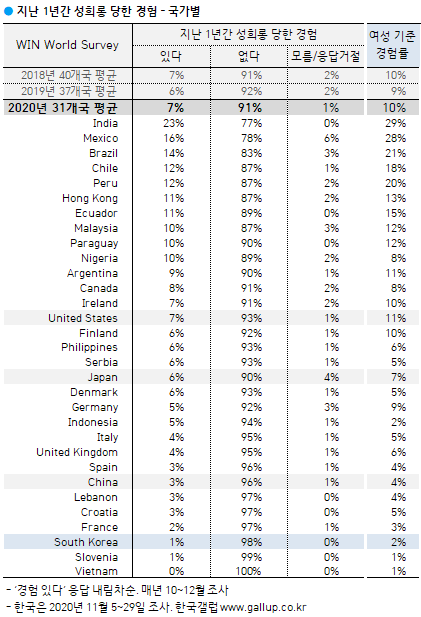
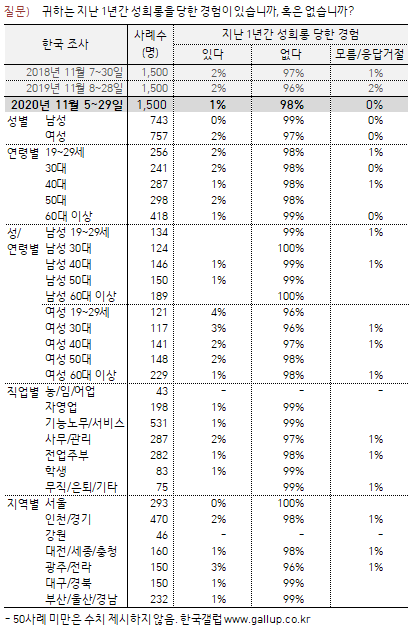
──────────────────────
Annual Survey Shows Low Level of Improvements in Gender Equality
──────────────────────
In a year where people have been forced to spend more time at home, and where the possibility to move and conduct a “normal” life have been highly restricted, the level of violence and sexual harassment already experienced by many women in past years might have been affected as well. WIN International, the world's leading association in market research and polling, published the Annual WIN World Survey(WWS-2020) exploring the views and beliefs of 29,252 individuals among citizens from 34 countries across the globe about gender equality, violence, and sexual harassment.
Many support the idea that domestic violence might have increased precisely due to the safety measures put in place during the pandemic. Others wonder whether the restrictions have had implications on gender equality. The research aims at monitoring the global data on violence and equality, and detecting the changes compared to previous years.
These are some of the conclusions and hypotheses by the new global research on the perceptions of inter-national superpowers and their policies, conducted by Gallup International Association at the end of 2020. The survey covers 45 countries around the world and more than 42,000 adult citizens, which represent about 2/3 of the global population.
Achievements in Gender Equality
As in previous measurements, gender equality is perceived the most at home, confirming the results of 2019 (from 72% to 71%). Considering that home became the center of our life, data support the idea that equality is more perceived in the place where we all spent most of our time.
The second place where individuals spent most of their time is definitely the workplace. On a global level, 60% of the respondents feel that gender equality at work is definitely or to what extent achieved, but the share of men believing that is higher than women’s (65% vs. 56% respectively).
However, although it increased by 3 points compared to last year (from 48% to 51%), perceived gender equality in politics is still very low, being the sector where men and women still struggle to be treated equally. In addition, perception varies a lot between men and women once again: 56% of men and 47% of women believe gender equality in politics is achieved in their country.
When looking at different age groups, young people are the most optimistic. Citizens 25-34 years old believe gender equality is better achieved than other age groups, especially at home (73%), at work (64%) and in politics (53%). The study also reveals that people with higher educational levels tend to share the same opinion.
To better evaluate how gender equality is perceived across countries, the net index was considered; the index ranks countries from those where gender equality is better achieved to the countries where improvements are still needed. Indexes at work and in politics rise slightly on a global level (from 25 to 26 points, and from 2 to 8 points, respectively), but there are a few important differences compared to 2019. The net index for gender equality in politics increases 5 points within men (from 12 to 17), and 7 points among women (from -7 to 0). Results by countries show that Finland is in the top 5 of the ranking for every category, namely work, politics and home (definitely + to some extent achieved: 80%, 90% and 86% respectively). On the other hand, Japan, like last year, scores negatively in all the evaluated fields.
Violence
Compared to previous years, there is little or no improvement in terms of violence suffered by women: results are unfortunately stable (17% in 2020, 16% in 2019 and 2018).
Although both regions show an improvement compared to last year, women in the Americas and women in Africa suffered from violence (physical or psychological) more so than women in other areas (23% and 24% respectively). MENA region falls not far behind from the top two, with 22% of women stating they suffered from violence in the past year. Europe and APAC have lower shares of women who experienced some kind of violence in 2020 (13% and 12% respectively), but the percentage in the APAC region increased by 4 points compared to 2019 (from 8% to 12%).
Consistent with previous results, women between 18 and 24 years old show the highest incidence of physical and psychological violence (24%), just like 2 out of 10 women with completed primary education (21%).
When looking at data by countries, the share of Indian women experiencing violence is higher than in other countries (48%), followed by Chilean and Argentine women (36% each). Lowest percentages are found in Vietnam (1%), China and South Korea (5%, each).
It is known that, in times of crisis, interpersonal violence might increase as a result of fear, financial and personal insecurity, and uncertainty.
Lockdowns and other safety measures restricted the possibility to move, allowed fewer family visits and made the support system in many cases unavailable. Therefore, when comparing data with previous years, it is important to keep considering the particular context brought by 2020, that has a strong influence also on the interpretation of the data.
Sexual harassment
Despite efforts and campaigns worldwide, results show no improvement: 10% of women suffered sexual harassment in the last year (2020), compared to 9% in 2019 and 10% in 2018. Young women (between the ages of 18 and 24) still register the highest rate of sexual harassment (18%).
Vilma Scarpino, President of WIN International Association, said:
Overall, figures do not improve significantly compared to last years. On a bright side, improvements were detected more on a regional level and from a country point of view. This also points to another consideration: data on equality and on violence significantly varies not only when it comes to gender (men and women have different views about it), but also when different countries and cultures, and therefore the different efforts put in place by governments and associations, are taken into account. Once we are aware about how different results can be achieved when different efforts are put in place, it becomes clear how to understand best practices and adapt them to help improving results and help women worldwide.”
_____
응답자 특성표
조사 결과는 행정안전부 주민등록인구 기준으로 가중 처리하여 최종 결과를 산출합니다. 아래 응답자 특성표의 조사완료 사례수는 실제 응답 완료한 인원, 가중값 적용 사례수는 2020년 6월 행정안전부 주민등록인구 기준 성/연령/지역별 셀 가중 처리 후 인원입니다.
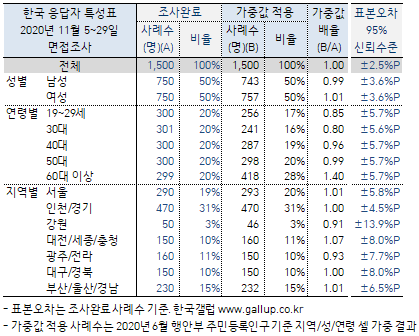
| 지난 3월 8일은 113주년 세계 여성의 날이었습니다. 이날은 1908년 3월 8일 미국의 여성 노동자들이 노동 환경 개선과 참정권 등을 요구하며 대규모 시위에 나선 데서 시작됐고, 1977년 유엔으로부터 '세계 여성의 날'로 공식 지정됐으며 우리나라에서는 2018년 법정기념일이 됐습니다. ● 전 대륙에서 시장조사와 여론조사를 하는 글로벌 네트워크 WIN(Worldwide Independent Network of Market Research)은 매년 말 건강, 환경, IT 등 여러 분야 현안에 관해 다국가 비교 조사를 하고 있습니다. 지난 연말 공개한 〈코로나19와 백신〉에 이어 오늘은 〈성평등 인식〉 조사 결과를 전합니다. 2018년, 2019년과 비교 가능합니다. |
성평등(Gender Equality) 관련 인식 - WIN 다국가 조사
→ 한국+세계 조사 결과 파일 다운로드(PDF)
/ 세계 조사 개요
2020년 10~12월 34개국 성인 총 29,252명 전화/온라인/면접조사(주제별 참여국 상이)
/ 한국 조사 개요
- 조사기간: 2020년 11월 5~29일
- 표본추출: 2단계 층화 집락 무작위 추출
- 응답방식: 면접조사원 인터뷰
- 조사대상: 전국(제주 제외) 만 19세 이상 1,500명
- 표본오차: ±2.5%포인트(95% 신뢰수준)
- 응답률: 26%(총 접촉 5,856명 중 1,500명 응답 완료)
- 의뢰처: 한국갤럽-WIN 자체 조사
/ 조사 항목
- 영역별 성평등 성취 여부: 일터·직장 / 정치 / 가정
- 지난 1년간 정신적, 신체적 등 어떤 형태의 폭력으로 고통받은 적이 있는가?
- 지난 1년간 성희롱을 당한 경험이 있는가?
(※ 세계 조사 상세 결과는 첨부 파일 참조)
요약
- 34개국 성인 영역별 성평등 성취 동의율: 가정 71%, 직장·일터 60%, 정치 51%
- 대체로 남성이 여성보다 더 성평등한 사회에 산다고 인식
- 핀란드는 3개 영역 모두 조사 참여국 중 5위 안, 일본은 매년 최하위권
- 한국은 다른 나라보다 남녀 간 시각차 큰 편
- 폭력에 따른 고통 경험률 높은 나라가 대체로 성희롱 피해 경험률도 높아
조사 결과
2020년 10~12월 34개국 성인, 영역별 성평등 성취 동의율:
가정 71%, 직장·일터 60%, 정치 51%
- 대체로 남성이 여성보다 더 성평등한 사회에 산다고 인식
- 한국은 조사 참여국 평균 수준이지만, 다른 나라보다 남녀 간 시각차 큰 편
글로벌 조사 네트워크 WIN이 2020년 10~12월 34개국 성인 29,252명에게 성평등이 얼마나 이뤄졌는지에 대한 주관적 인식을 일터·직장, 정치, 가정 등 3개 영역별로 물었다(4점 척도). 그 결과 34개국 성인 중 71%가 자국의 가정에서 '성평등이 (확실히+어느 정도) 이뤄졌다'고 답했다. 직장·일터에서 '성평등이 이뤄졌다'(이하 '성취')는 응답은 60%, 정치 영역에 대해서는 51%로 나타났다.
◎ 34개국 중에서 핀란드는 영역별 성평등 성취 응답(일터·직장 80%, 정치 90%, 가정 86%)이 모두 5위 안에 들었다. 반면, 일본(일터·직장 32%, 정치 19%, 가정 45%)은 예년과 마찬가지로 최하위권에 머물렀다.
◎ 이번 조사는 34개국 성인이 자국에서 성평등이 얼마나 이루어졌다고 느끼는지에 대한 인식만을 알아본 것이다. 유엔개발계획(UNDP)의 성불평등지수(GII)나 세계경제포럼(WEF)의 성별격차지수(GGI) 등은 주로 국가 통계, 법적·경제적 제도와 권리 등 여러 측면을 포괄하여 산출된다는 차이가 있다. 즉, 개인이 느끼는 자국의 성평등 정도가 반드시 그 나라의 객관적 성평등 수준을 의미하는 것은 아님에 주의해야 한다.
◎ 국가별, 응답자 특성별 성평등 성취 여부 인식 비교를 좀 더 쉽게 하기 위해 순(純)지수(Net Score: 성취-미성취 응답 차이, 수치가 클수록 더 성평등하다고 느낌) 기준으로 보면 34개국 전체 평균은 가정 47, 일터·직장 26, 정치 8 순이다. 1년 전과 비교하면 정치 영역에서 성평등 성취 순지수가 소폭 상승했고(2→8) 일터·직장(25→26), 가정(48→47) 영역은 거의 변함없었다.
◎ 3개 영역 성평등 성취 순지수를 성별로 보면 정치에서 남성(17)과 여성(0) 차이가 17, 일터·직장(남성 35, 여성 18)에서는 17, 가정(53, 40)에서 13이다. 즉, 전반적으로 남성이 여성보다 더 성평등한 사회에 산다고 느끼는 것이다. 이는 지난 3년간 조사에서 일관된 경향이다.
◎ 한국 조사는 작년 11월 5~29일 전국(제주 제외) 성인 1,500명을 대상으로 했다. 그 결과 한국인의 영역별 성평등 성취 응답은 가정 73%, 일터·직장 61%, 정치 영역 48%로 나타났다. 이는 조사 참여국 평균과 비슷한 수준이지만, 다른 나라보다 남녀 간 시각차가 큰 편이라는 데 주목할 만하다.





__
한국 교차 집계표



___
33개국 성인 중 15%, '지난 1년간 어떤 형태의 폭력으로 고통받은 적 있다'
- 주요국 경험률: 인도 40%... 일본·미국 12%, 중국·한국 5%
33개국 성인에게 지난 1년간 정신적·신체적 등 어떤 형태의 폭력으로 고통받은 적 있는지 물은 결과 15%가 '있다'고 답했다. 폭력으로 고통받은 경험률은 남성 14%, 여성 17%다. 연령별로 보면 젊은 층에서 그 비율이 높았다(18~24세 21%, 25~34세 18%; 55~64세 11%, 65세 이상 6%).
◎ 조사 참여국 중 지난 1년간 어떤 형태의 폭력으로 고통받은 경험률이 가장 높은 나라는 인도(40%), 아르헨티나(31%), 칠레(30%), 멕시코(27%) 순이다. 그 외 주요국 경험률은 홍콩 19%, 일본과 미국이 각각 12%, 독일 8%, 영국 6% 등이며 한국은 5%로, 중국(5%), 베트남(1%)과 함께 낮은 편에 속했다.


___
31개국 성인 중 7%, '지난 1년간 성희롱 당한 경험 있다' - 여성은 10%
- 주요국 경험률: 인도(23%)... 미국 7%, 일본 6%, 중국 3%, 한국 1%
- 폭력에 따른 고통 경험률 높은 나라가 대체로 성희롱 피해 경험률도 높아
31개국 성인 중 7%가 지난 1년간 성희롱을 당한 경험이 있다고 답했으며, 여성의 성희롱 피해 경험률은 10%에 달했다. 조사 참여국 중 지난 1년간 성희롱 피해 경험률이 가장 높은 나라는 인도(23%), 멕시코(16%), 브라질(14%), 칠레·페루(12%) 순이다. 한국은 1%로, 슬로베니아(1%), 베트남(0%) 등과 함께 낮은 편에 속했다. 폭력에 따른 고통 경험률이 높은 나라는 대체로 성희롱 피해 경험률도 높았다.
◎ 단, 이번 조사에서는 '성희롱(Sexual harassment)'이라는 단어에 부가적인 설명이나 예시 없이 질문하고 답을 받았음에 주의해야 한다. 친밀한 관계에서의 언어적·신체적 접촉이나 공공장소에서의 애정 표현 등에 대한 수용 정도는 문화적 배경이나 나라별 상황에 따라 크게 다를 수 있다.
예를 들어, 우리나라 여성가족부가 주관한 〈2018년 성희롱 실태조사〉(3년 주기 국가승인통계 제154018호)에서는 직장 내 성희롱 피해 경험률이 8.1%로 파악됐다. 그 수치는 '외모에 대한 성적 비유나 평가', '음담패설 및 성적 농담', '회식에서 술을 따르거나 옆에 앉도록 강요하는 행위' 등 구체적인 행위를 적시하고 이를 포괄하여 성희롱 피해 경험으로 집계한 결과다.


──────────────────────
Annual Survey Shows Low Level of Improvements in Gender Equality
──────────────────────
In a year where people have been forced to spend more time at home, and where the possibility to move and conduct a “normal” life have been highly restricted, the level of violence and sexual harassment already experienced by many women in past years might have been affected as well. WIN International, the world's leading association in market research and polling, published the Annual WIN World Survey(WWS-2020) exploring the views and beliefs of 29,252 individuals among citizens from 34 countries across the globe about gender equality, violence, and sexual harassment.
Many support the idea that domestic violence might have increased precisely due to the safety measures put in place during the pandemic. Others wonder whether the restrictions have had implications on gender equality. The research aims at monitoring the global data on violence and equality, and detecting the changes compared to previous years.
These are some of the conclusions and hypotheses by the new global research on the perceptions of inter-national superpowers and their policies, conducted by Gallup International Association at the end of 2020. The survey covers 45 countries around the world and more than 42,000 adult citizens, which represent about 2/3 of the global population.
Achievements in Gender Equality
As in previous measurements, gender equality is perceived the most at home, confirming the results of 2019 (from 72% to 71%). Considering that home became the center of our life, data support the idea that equality is more perceived in the place where we all spent most of our time.
The second place where individuals spent most of their time is definitely the workplace. On a global level, 60% of the respondents feel that gender equality at work is definitely or to what extent achieved, but the share of men believing that is higher than women’s (65% vs. 56% respectively).
However, although it increased by 3 points compared to last year (from 48% to 51%), perceived gender equality in politics is still very low, being the sector where men and women still struggle to be treated equally. In addition, perception varies a lot between men and women once again: 56% of men and 47% of women believe gender equality in politics is achieved in their country.
When looking at different age groups, young people are the most optimistic. Citizens 25-34 years old believe gender equality is better achieved than other age groups, especially at home (73%), at work (64%) and in politics (53%). The study also reveals that people with higher educational levels tend to share the same opinion.
To better evaluate how gender equality is perceived across countries, the net index was considered; the index ranks countries from those where gender equality is better achieved to the countries where improvements are still needed. Indexes at work and in politics rise slightly on a global level (from 25 to 26 points, and from 2 to 8 points, respectively), but there are a few important differences compared to 2019. The net index for gender equality in politics increases 5 points within men (from 12 to 17), and 7 points among women (from -7 to 0). Results by countries show that Finland is in the top 5 of the ranking for every category, namely work, politics and home (definitely + to some extent achieved: 80%, 90% and 86% respectively). On the other hand, Japan, like last year, scores negatively in all the evaluated fields.
Violence
Compared to previous years, there is little or no improvement in terms of violence suffered by women: results are unfortunately stable (17% in 2020, 16% in 2019 and 2018).
Although both regions show an improvement compared to last year, women in the Americas and women in Africa suffered from violence (physical or psychological) more so than women in other areas (23% and 24% respectively). MENA region falls not far behind from the top two, with 22% of women stating they suffered from violence in the past year. Europe and APAC have lower shares of women who experienced some kind of violence in 2020 (13% and 12% respectively), but the percentage in the APAC region increased by 4 points compared to 2019 (from 8% to 12%).
Consistent with previous results, women between 18 and 24 years old show the highest incidence of physical and psychological violence (24%), just like 2 out of 10 women with completed primary education (21%).
When looking at data by countries, the share of Indian women experiencing violence is higher than in other countries (48%), followed by Chilean and Argentine women (36% each). Lowest percentages are found in Vietnam (1%), China and South Korea (5%, each).
It is known that, in times of crisis, interpersonal violence might increase as a result of fear, financial and personal insecurity, and uncertainty.
Lockdowns and other safety measures restricted the possibility to move, allowed fewer family visits and made the support system in many cases unavailable. Therefore, when comparing data with previous years, it is important to keep considering the particular context brought by 2020, that has a strong influence also on the interpretation of the data.
Sexual harassment
Despite efforts and campaigns worldwide, results show no improvement: 10% of women suffered sexual harassment in the last year (2020), compared to 9% in 2019 and 10% in 2018. Young women (between the ages of 18 and 24) still register the highest rate of sexual harassment (18%).
Vilma Scarpino, President of WIN International Association, said:
Overall, figures do not improve significantly compared to last years. On a bright side, improvements were detected more on a regional level and from a country point of view. This also points to another consideration: data on equality and on violence significantly varies not only when it comes to gender (men and women have different views about it), but also when different countries and cultures, and therefore the different efforts put in place by governments and associations, are taken into account. Once we are aware about how different results can be achieved when different efforts are put in place, it becomes clear how to understand best practices and adapt them to help improving results and help women worldwide.”
_____
응답자 특성표
조사 결과는 행정안전부 주민등록인구 기준으로 가중 처리하여 최종 결과를 산출합니다. 아래 응답자 특성표의 조사완료 사례수는 실제 응답 완료한 인원, 가중값 적용 사례수는 2020년 6월 행정안전부 주민등록인구 기준 성/연령/지역별 셀 가중 처리 후 인원입니다.
